Get to know your cat better by learning the subtle language they use. Here are 35 crucial signals that all cat owners should be able to recognize.
Cats are enigmatic beings, and figuring out their behavior can be a puzzling task. By recognizing these important cues, you can improve your communication with your cherished feline companion and guarantee their health and contentment.
By paying attention to subtle cues in body language and clear vocalizations, you can strengthen your bond with your feline friend and become a more attentive and responsible cat parent.
Healthy Eating Signs
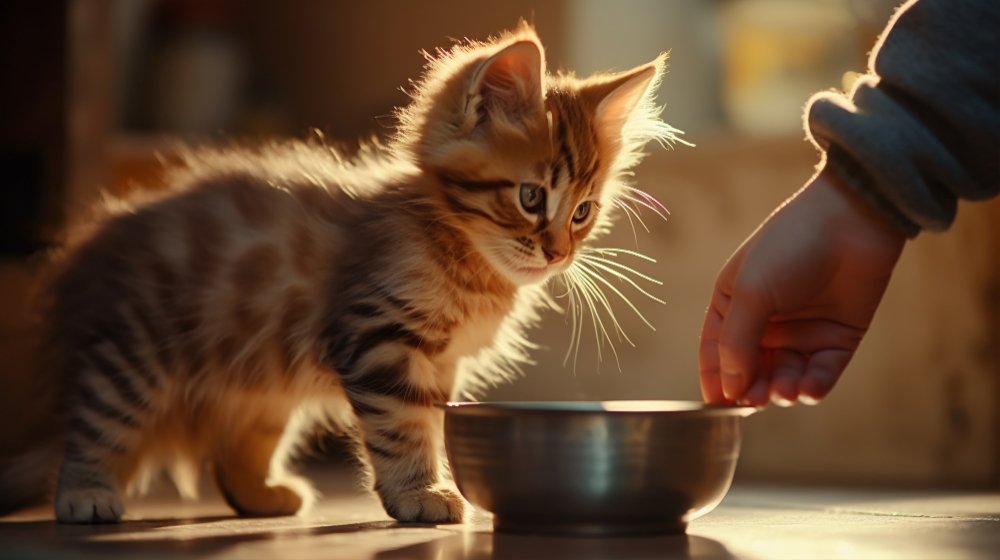
The key to a happy and healthy cat lies in their diet. As a responsible cat owner, it is crucial to keep an eye on your feline friend’s eating habits to ensure they are getting the right nutrition. Check out these necessary signs to look out for when it comes to your cat’s eating behavior.
Consistent appetite
For a cat, having a consistent appetite is a good indicator of their overall health. If your cat has a healthy appetite and is eating their meals without any hesitation, it usually means they are in good spirits and feeling well. However, sudden changes in appetite, such as eating significantly more or less than usual, could be a sign of an underlying health issue and should be addressed promptly.
Additionally, keeping track of your cat’s eating habits can help you monitor their weight and ensure they are maintaining a healthy body condition. Cats that are consistently eating the right amount of food for their size and activity level are more likely to have a balanced diet and stay at a healthy weight.
Normal drinking habits
Appetite isn’t the only eating behavior to monitor – observing your cat’s drinking habits is also necessary for their overall well-being. Cats typically drink small amounts of water throughout the day, and it’s crucial to ensure they are staying hydrated. Normal drinking habits for a cat include visiting their water bowl multiple times a day and consuming an adequate amount of water to prevent dehydration.
Plus, changes in drinking habits, such as drinking excessively or not drinking at all, could be a red flag for various health problems, including kidney disease or diabetes.
If you notice any significant changes in your cat’s water consumption, it is recommended to consult your veterinarian for further evaluation and guidance on how to address the issue.
Positive Play Behavior
Little feline friends are known for their playful antics and boundless energy. Understanding the nuances of their play behavior is crucial for fostering a happy and healthy relationship with your cat.
Interactive play interest
Interactive play is crucial for keeping your cat mentally stimulated and physically active. Cats are natural hunters, and interactive play simulates this instinctual behavior. Toys that mimic prey, such as feather wands or laser pointers, can help engage your cat in play and provide them with much-needed exercise.
Encouraging interactive play can also strengthen the bond between you and your cat. By actively engaging in play sessions, you are not only providing your cat with entertainment but also building trust and companionship.
Appropriate play aggression
One important aspect of play behavior to be mindful of is appropriate play aggression. Cats may exhibit behaviors such as pouncing, chasing, or swatting during play, which are normal expressions of their predatory instincts. It’s crucial to understand the difference between playful aggression and actual aggression to ensure a safe and positive play experience.
A key component of appropriate play aggression is setting boundaries and redirecting any overly aggressive behavior. If your cat becomes too rough during play, gently stop the interaction and provide them with an alternative toy to focus their energy on. Consistent reinforcement of acceptable play behavior can help prevent any potential issues in the future.
Good Litter Box Practices
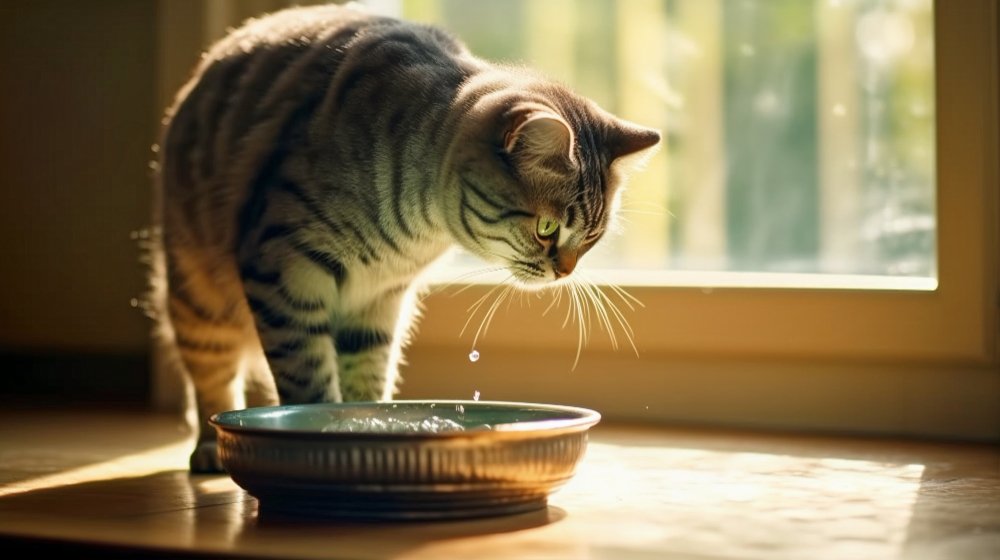
It’s vital for cat owners to pay attention to their cats’ litter box habits in order to maintain a clean and healthy environment for both the cat and the household. By following good litter box practices, you can ensure that your cat stays happy and healthy.
Regular litter box use
Regular cleaning and maintenance of the litter box is crucial to encourage your cat to use it consistently. Cats are clean animals by nature and prefer a clean and odor-free environment.
Make sure to scoop the litter box at least once a day and completely change the litter every 1-2 weeks to keep it fresh and inviting for your cat.
In order to promote good litter box behavior, it is crucial to have an adequate number of litter boxes in your home. A good rule of thumb is to have one litter box for each cat, plus an additional one. This will provide each cat with multiple options and decrease the chances of accidents occurring outside the litter box.
Clean elimination patterns
Regular maintenance of the litter box also helps you monitor your cat’s elimination patterns. Cats are creatures of habit, and any changes in their litter box habits could indicate an underlying health issue. Keep an eye out for changes in frequency, amount, or appearance of urine or feces.
For instance, if your cat starts to eliminate outside the litter box or strain while using it, it could be a sign of a urinary tract infection or other health problem. In such cases, it’s essential to consult your veterinarian as soon as possible to address the issue and prevent any further complications.
Alertness and Energy Levels
Once again, understanding your cat’s behaviors and energy levels is crucial for a healthy and happy feline companion. Cats are known for their unique expressions of alertness and varying energy levels, which can indicate their overall well-being and contentment.
Active and curious behavior
For many cat owners, observing their feline friend’s active and curious behavior is a delightful experience. Cats that are bright-eyed, playful, and constantly exploring their surroundings often exhibit high levels of energy and mental stimulation. These cats may engage in playful antics, pouncing on toys, climbing furniture, and investigating every nook and cranny of their environment.
On the other hand, sudden changes in activity levels or a lack of interest in play may be a cause for concern. Cats that appear lethargic, disinterested, or unusually withdrawn may be signaling an underlying health issue that warrants a visit to the vet for further evaluation.
Consistent sleeping patterns
According to sleepfoundation.org, Patterns of consistent sleeping behavior are another important indicator of a cat’s well-being. Cats are crepuscular animals, meaning they are most active during dawn and dusk. As a result, it is normal for cats to have several short bursts of energy throughout the day, followed by periods of rest and relaxation.
With that said, sudden changes in your cat’s sleeping patterns, such as excessive lethargy, sleeping more than usual, or difficulty waking up, may point to an underlying health problem. Keeping track of your cat’s typical sleep routine can help you identify any deviations and seek prompt veterinary attention if needed.
Social Interaction Cues
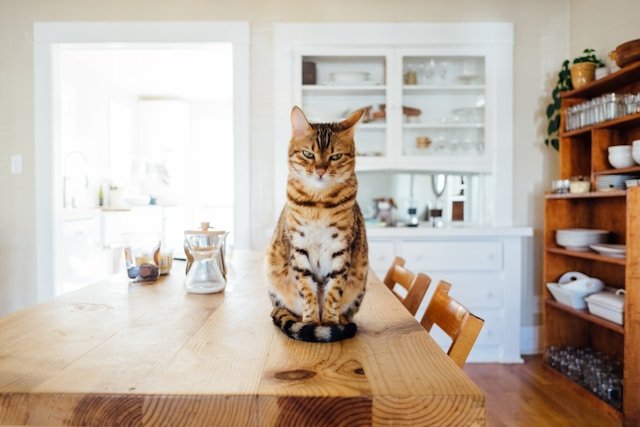
Seeking affection regularly
Cues for seeking affection from your cat regularly include purring, rubbing against you, kneading with their paws, and gently head-butting you. These behaviors indicate that your cat is seeking attention, affection, and companionship from you. You have to recognize and respond to these cues to strengthen the bond between you and your feline friend.
If your cat jumps onto your lap, curls up beside you, or nudges your hand with their head, these are all signs that they crave physical contact and enjoy being close to you. By reciprocating these actions with gentle strokes, petting, and talking to your cat, you can show them that you appreciate their affectionate gestures.
Comfortable with familiar people
One of the key signs that your cat is comfortable with familiar people is their relaxed body language. They may approach visitors with their tail held high, ears forward, and a calm demeanor. If your cat initiates interaction with guests by rubbing against them or allowing them to pet them, this indicates that they trust and feel at ease with the individuals present.
Seeking affection and comfort from familiar people is a positive indication of your cat’s social nature and their ability to form strong bonds with those they are comfortable with. By observing these cues, you can ensure that your cat feels secure and happy in their social interactions.
Grooming and Appearance
Cats are notorious for their impeccable grooming habits and stunning appearance. As a cat owner, it’s essential to understand the crucial signs related to grooming and appearance to ensure your furry friend is healthy and happy. Let’s explore into the key indicators to watch out for in this department.
Consistent self-grooming
Consistent self-grooming is a distinctive behavior in cats. If you notice your cat spending a significant amount of time grooming themselves, it’s a positive sign of good health. Cats use their rough tongues to clean their fur, removing dirt, debris, and loose hair. It’s a natural instinct that also helps distribute oils throughout their coat for a healthy shine.
However, a sudden decrease in grooming behavior could indicate an underlying health issue or discomfort. Keep an eye out for any changes in your cat’s grooming routine, as it could be a red flag for potential problems that need to be addressed promptly.
Healthy fur condition
On top of consistent grooming, maintaining a healthy fur condition is crucial for your cat’s overall well-being. A shiny and smooth coat is a sign of a healthy cat. Brushing your cat regularly not only helps prevent mats and tangles but also allows you to check for any abnormalities such as bald patches, redness, or skin irritations.
For instance, excessive shedding or dull, dry fur could indicate nutritional deficiencies, parasites, or even stress. If you notice any concerning changes in your cat’s fur condition, consulting your veterinarian for a thorough examination and guidance is recommended to address any potential issues effectively.
Vocalization and Communication
For cat owners, understanding feline vocalization and communication is imperative in building a strong bond with your furry feline. Cats use a variety of sounds and body language to convey their needs and emotions, and being able to interpret these signals can greatly enhance your relationship with your cat.
Normal meow volume
The meow is the most common vocalization emitted by cats, with different meanings conveyed through variations in volume and tone.
Typically, a normal meow is soft to moderate in volume and is often used by cats to greet their owners, seek attention, or indicate contentment.
By paying attention to the pitch and length of your cat’s meows, you can gain better insight into their wants and feelings.
Some cats may have naturally loud meows, while others may be more quiet and reserved. Understanding your cat’s normal meow volume can help you recognize any changes in their vocal patterns, which could indicate distress, illness, or discomfort.
Context-appropriate vocal sounds
Sounds other than meows, such as chirps, trills, and chatters, are also common forms of feline communication that can convey a range of emotions and needs. Cats may use chirps to greet their owners, express excitement, or signal their desire for attention. Trills are often used as a friendly acknowledgment or invitation to play, while chatters typically indicate curiosity or frustration.
This variety of context-appropriate vocal sounds allows cats to communicate with their owners in a nuanced way, enhancing the bond between human and feline. By paying attention to these sounds and the accompanying body language, cat owners can better respond to their cat’s needs and strengthen their relationship.
Body Language Indicators
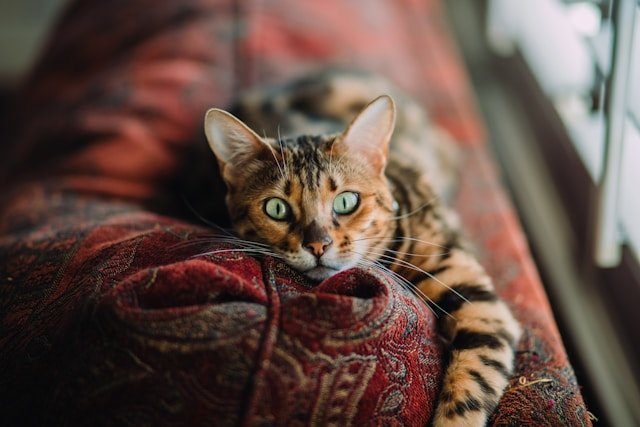
Now, as a cat owner, understanding your feline companion’s body language is crucial for deciphering their feelings and needs. Cats use various physical cues to communicate with their human counterparts, and being able to interpret these signals can help strengthen the bond between you and your furry friend.
Tail and Ear Positioning
An important aspect of cat body language is tail and ear positioning. A cat’s tail can convey a range of emotions, from happiness and contentment to fear and aggression. When a cat holds its tail upright with a slight curve at the top, it typically indicates a friendly and approachable mood. Conversely, a puffed-up tail can signal fear or aggression, suggesting that the cat feels threatened or uncomfortable.
With ear positioning, a cat’s ears can also provide valuable insights into their current state of mind. Forward-facing ears usually indicate that a cat is feeling curious or playful, while flattened ears suggest agitation or fear. Paying attention to these subtle cues can help you better understand and respond to your cat’s emotions.
Body Posture and Movement
An important component of cat body language is their posture and movement. The way a cat positions its body and moves can reveal a lot about how they are feeling. For instance, a cat crouching low to the ground with dilated pupils may be preparing to pounce or feeling defensive. On the other hand, a cat laying on its back with exposed belly is often a sign of trust and relaxation.
For instance, sudden and jerky movements may indicate that the cat is feeling agitated or overstimulated. Conversely, slow and deliberate movements usually suggest a calm and focused state of mind. By observing your cat’s body language closely, you can better understand their needs and provide appropriate care and attention.
Eyes and Vision Clarity
Bright, clear eyes
One of the imperative signs to watch out for in your cat is the appearance of their eyes. Bright and clear eyes indicate good health and vitality in your feline friend. The eyes should be free from any cloudiness, discharge, or redness.
Regularly check your cat’s eyes for any abnormalities or changes. If you notice any unusual symptoms such as squinting, excessive blinking, or changes in eye color, it is crucial to seek veterinary attention promptly to ensure your cat’s eyesight remains in optimal condition.
No excessive tearing
Clear vision is essential for your cat’s well-being. If you notice your cat’s eyes tearing excessively or being watery, it could indicate health problems like infections, allergies, or blocked tear ducts. It’s important to keep an eye on your cat’s tear production and consult a veterinarian if the tearing persists.
Excessive tearing can lead to discomfort for your cat and may indicate an underlying problem that needs to be addressed. Keeping your cat’s eyes clear and free from excessive tearing will help maintain their overall well-being and vision clarity.
Nose and Whisker Health
Many cat owners may wonder about the health of their feline friends’ noses and whiskers. These features are not just cute additions to their faces; they play a crucial role in a cat’s overall well-being. Understanding the signs of nose and whisker health can help you ensure your cat’s comfort and happiness.
Moist nose condition
Given that a cat’s nose is a prominent feature, it is crucial to monitor its moisture levels. A cat’s nose should generally feel cool and moist.
If you observe that your cat’s nose is extremely dry or too wet, it may signal an underlying health problem that necessitates veterinary care.
Keeping an eye on your cat’s nose can offer valuable information about their overall well-being.
In some cases, changes in a cat’s nose moisture levels can be attributed to environmental factors such as temperature and humidity. However, persistent dryness or wetness should not be ignored, as it could be a sign of allergies, skin conditions, or respiratory issues.
Keeping an eye on your cat’s nose condition and seeking professional advice when needed can help you address any potential health concerns early on.
Whiskers free of damage
To maintain your cat’s whisker health, it’s vital to ensure that their whiskers remain free of damage. Whiskers are highly sensitive and play a crucial role in helping cats navigate their surroundings. Damaged or broken whiskers can disrupt a cat’s spatial awareness and cause discomfort. Regularly inspect your cat’s whiskers for any signs of breakage or bending.
It’s natural for a cat’s whiskers to shed and regrow over time, but if you notice excessive breakage or damage, it could be a sign of your cat engaging in activities that put their whiskers at risk. Avoid trimming or cutting your cat’s whiskers, as this can cause them distress and affect their sense of balance. Providing your cat with a safe and enriched environment can help prevent damage to their whiskers and promote their overall well-being.
Nose and whisker health are important aspects of your cat’s overall well-being. By monitoring these features regularly and seeking professional advice when necessary, you can ensure that your feline companion stays healthy and happy.
Ear Health Signals
Your cat’s ear health is important to their overall well-being. Understanding the signs that indicate potential issues can help you provide timely care and attention to your feline friend. Here are some important ear health signals every cat owner needs to know!
Clean inner ear
Any signs of redness, swelling, discharge, or foul odor in your cat’s inner ear may indicate an infection or ear mites. Regularly check your cat’s ears for these symptoms and consult your vet if you notice anything unusual. Keeping the inner ear clean and free of debris can help prevent common ear issues in cats.
Regular grooming and inspection of your cat’s ears can also help you detect any potential problems early on. Use a damp cotton ball to gently clean the outer part of the ear, avoiding inserting anything into the ear canal. If you notice excessive wax buildup or debris, consult your vet for guidance on safe cleaning methods.
No excess scratching
The constant scratching of the ears or shaking of the head can be a sign that your cat is experiencing discomfort, itching, or pain in their ears. The underlying causes can range from infections to allergies, parasites, or even ear canal blockages. It is important to observe your cat’s behavior and consult your vet if you notice any excessive scratching.
For instance, ear mites are common parasites that can cause intense itching and irritation in cats’ ears. If left untreated, they can lead to secondary infections and ear damage. Regular check-ups and preventive measures can help you keep your cat’s ears healthy and free from unwanted guests.
Dental Health Signs
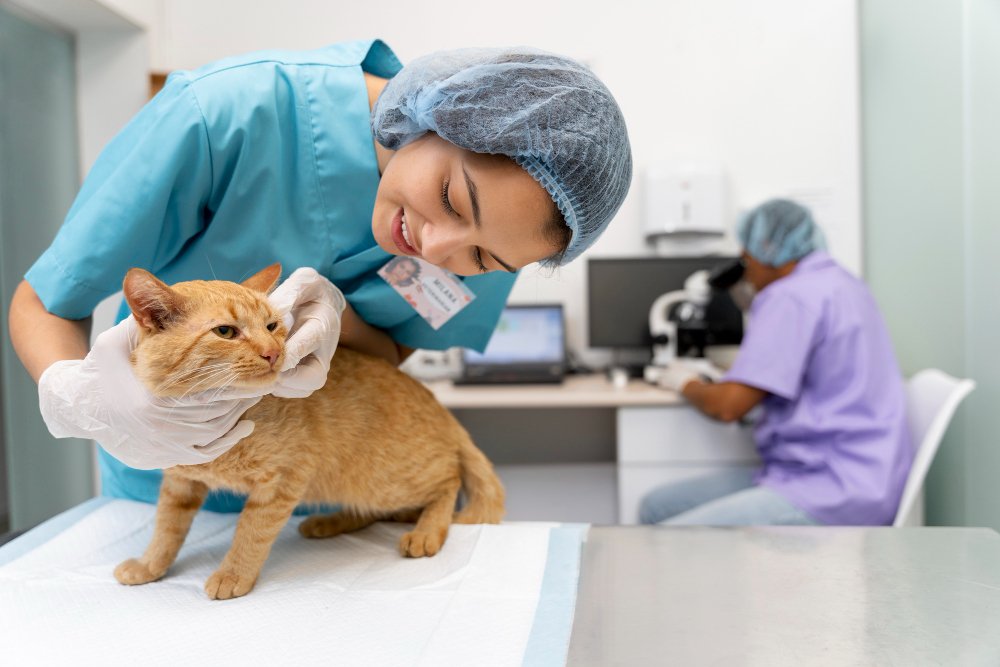
Clean teeth, healthy gums
One of the vital signs of good dental health in cats is clean teeth and healthy gums. Check your cat’s teeth regularly for any signs of tartar buildup, which looks like yellow or brown deposits on the teeth. Healthy gums should be pink and firm, not red, swollen, or bleeding.
Brushing your cat’s teeth regularly can prevent tartar buildup and maintain healthy gums. You can use a cat-specific toothbrush and toothpaste to clean your cat’s teeth. If your cat is resistant to brushing, there are also dental treats and toys available that can help with keeping their teeth clean.
No bad breath
Health cats should not have bad breath. If your cat’s breath is consistently foul-smelling, it may indicate an underlying dental problem such as periodontal disease or an infection. Bad breath can also be a sign of other health issues, so it is vital to have your cat examined by a veterinarian if you notice persistent bad breath.
Regular dental check-ups and cleanings by a veterinarian can help prevent dental issues that may cause bad breath in cats. Your vet can also provide guidance on proper dental care and recommend specific products to help maintain your cat’s oral health.
No bad breath in cats is more than just a cosmetic issue. It can be a sign of underlying dental problems that can impact your cat’s overall health and well-being. Proper dental care is vital for maintaining your cat’s oral health and preventing more severe dental issues in the future.
Remember that as a cat owner, you play a crucial role in maintaining your cat’s dental health. By being proactive in monitoring for signs of dental problems and implementing a proper dental care routine, you can help ensure that your cat’s teeth and gums stay healthy for years to come.
Coat and Skin Condition
While cats are often seen as independent creatures, they require a good deal of care and attention, especially when it comes to keeping their coat and skin healthy.
The condition of a cat’s coat and skin can serve as a reflection of their overall well-being, underscoring the importance for cat owners to carefully monitor for any signs of changes or abnormalities.
Shiny, smooth coat
An important sign of a healthy cat is a shiny, smooth coat. A well-nourished cat will have a coat that glistens in the sunlight and feels soft to the touch. Regular grooming plays a significant role in maintaining a cat’s coat health, as it helps to distribute natural oils evenly and remove dead hair. Moreover, a balanced diet rich in important nutrients like Omega-3 fatty acids can also contribute to a shiny and smooth coat.
Changes in a cat’s coat, such as dullness, dryness, or excessive shedding, could indicate underlying health issues that require attention. Consulting with a veterinarian can help pinpoint the cause of these changes and address any potential health concerns to ensure your cat maintains a healthy coat.
No itching or flaking
Flaking skin or excessive itching is a clear indication that something may be amiss with your cat’s skin condition. While cats naturally groom themselves, constant scratching or visible flaking could point to skin irritation, allergies, or even parasites. Regularly inspecting your cat’s skin for any signs of redness, irritation, or flakiness can help catch potential issues early on.
In addition to regular grooming and monitoring, providing a balanced diet with proper hydration can also contribute to a cat’s skin health. Hydrated skin is less prone to dryness and irritation, so ensuring your cat has access to fresh water at all times is important for maintaining healthy skin.
Paw and Claw Health
Keep a close eye on your feline friend’s paw and claw health to ensure they lead a comfortable and happy life. Regularly checking and maintaining their claws and pads is imperative for their overall well-being.
Normal Claw Growth
Health claws are crucial for a cat’s natural behavior like scratching and hunting. Normal claw growth is imperative for your cat’s comfort and health. Cats’ claws grow continuously, and they need to scratch to help shed the outer layers of their claws to keep them healthy.
Regularly trimming your cat’s claws can prevent them from becoming overgrown and causing discomfort or potential health issues. If you are unsure how to trim your cat’s claws, consult with your veterinarian or a professional groomer for guidance.
Pads free of injury
Injury to the pads of a cat’s paws can be painful and lead to infections. It is crucial to regularly check your cat’s pads for any signs of injury, such as cuts, burns, or foreign objects embedded in them. Keeping your cat’s pads free of injury is vital for their mobility and overall well-being.
Ensure your cat’s environment is safe and free of any potential hazards that could cause injury to their pads. If you notice any signs of injury to your cat’s pads, consult with your veterinarian for proper treatment and care.
Weight and Shape
All cat owners should pay close attention to their feline friend’s weight and shape as it can have a significant impact on their overall health and wellbeing. By understanding these signs related to weight and shape, you can ensure your cat stays healthy and happy for years to come.
Maintaining healthy weight
On a regular basis, it’s vital to monitor your cat’s weight to ensure they are maintaining a healthy balance. Overweight cats can be prone to various health issues, such as diabetes, arthritis, and heart disease. On the other hand, underweight cats may indicate underlying medical problems or improper nutrition. Consult your veterinarian to determine the ideal weight for your cat based on their breed, age, and lifestyle.
To help your cat maintain a healthy weight, focus on providing a balanced diet with the right amount of calories for their activity level. Incorporate interactive play sessions to keep them active and engage in bonding activities that promote physical exercise. Avoid overfeeding or feeding excessive treats, as this can lead to weight gain and other health complications.
Visible waistline
For cat owners, being able to identify a visible waistline is crucial in determining if your cat is at a healthy weight. A cat with an ideal body condition should have a noticeable waistline when viewed from above and from the side. This waistline indicates that your cat has a healthy amount of muscle and body fat.
For some cat breeds, such as the Maine Coon or the British Shorthair, a naturally rounder body shape may make it more challenging to identify a visible waistline. In such cases, rely on touch as well – you should be able to feel your cat’s ribs with a gentle touch but without them being prominently visible.
Regular vet check-ups and weight assessments can also help you track your cat’s progress and make necessary adjustments to their diet and exercise routine.
Shape is an important indicator of your cat’s overall health and well-being. By understanding the significance of maintaining a healthy weight and recognizing a visible waistline, you can proactively promote your cat’s wellness and longevity. Note, a healthy cat is a happy cat!
Respiratory Health
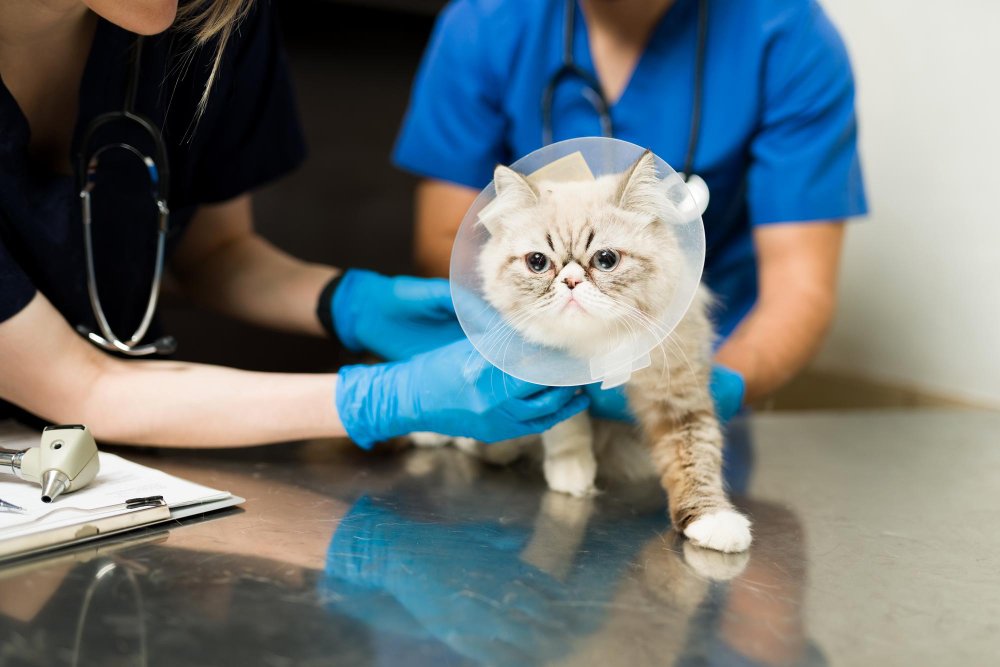
Despite their reputation for being independent and aloof, cats rely on their owners to monitor their health and well-being. One crucial aspect of a cat’s health is their respiratory system. By paying attention to certain signs and symptoms, you can ensure your feline friend stays happy and healthy for years to come. Here are 35 important signs that every cat owner needs to know!
Regular breathing pattern
Any changes in your cat’s breathing pattern can indicate an underlying health issue. A healthy cat should have a regular breathing rate of 20-30 breaths per minute while resting. Rapid or labored breathing, also known as dyspnea, can be a sign of respiratory distress or heart problems. Keeping an eye on your cat’s breathing can help catch any issues early and prevent further complications.
It’s also important to observe your cat’s breathing while they are asleep. Cats can dream just like humans, and you may notice changes in their breathing pattern during deep sleep. However, if you notice any sudden changes in their breathing, such as gasping or struggling for breath, it’s crucial to seek veterinary attention immediately.
No wheezing or coughing
A key sign of good respiratory health in cats is the lack of wheezing or coughing. Wheezing typically indicates narrowed airways or inflammation, while coughing could signal respiratory infections or other problems. If your cat is wheezing or coughing frequently, it’s crucial to have them checked by a vet to identify the root cause and administer suitable treatment.
If your cat wheezes or coughs, make sure to observe any additional symptoms like runny nose, tiredness, or loss of appetite. These signs can assist the vet in making a precise diagnosis and creating a treatment plan that suits your cat’s individual requirements.
Gastrointestinal Signals
To ensure the health and well-being of your feline companion, it is crucial to be aware of the signs and signals that their gastrointestinal system may exhibit.
By recognizing signs such as regular bowel movements or symptoms of vomiting and diarrhea, you can identify possible health concerns at an early stage, aiding in proactive intervention.
Normal Bowel Movements
Normal bowel movements in cats are characterized by being well-formed, brown in color, and easily passed without straining. Frequency can vary among cats, but most cats should have bowel movements at least once a day.
Changes in frequency, consistency, color, or odor may indicate an underlying issue such as dietary intolerance, infection, or gastrointestinal disease.
It is vital to monitor your cat’s litter box regularly to observe any changes in their bowel movements. If you notice persistent abnormalities, it is advisable to consult your veterinarian for further evaluation and appropriate management.
No Vomiting or Diarrhea
To maintain optimal gastrointestinal health, cats should not experience frequent vomiting or diarrhea. Vomiting can be caused by various factors such as dietary indiscretion, hairballs, or underlying medical conditions. Diarrhea, on the other hand, may result from dietary changes, infections, parasites, or gastrointestinal disorders.
For instance, if your cat is vomiting occasionally after eating grass or hairballs, it may be considered normal behavior. However, persistent or frequent vomiting, along with diarrhea, lethargy, or loss of appetite, requires prompt veterinary attention to determine the underlying cause and initiate appropriate treatment.
Hydration Status
Now let’s talk about how to assess your cat’s hydration status, an important aspect of their overall health and well-being.
Skin elasticity
To check your cat’s hydration level, gently pinch the skin on the back of their neck or between the shoulder blades. In a well-hydrated cat, the skin should snap back into place immediately. If the skin takes longer to return to normal or remains tented, it could indicate dehydration.
There are several factors that can lead to dehydration in cats, including illness, exposure to heat, or inadequate water intake. If you observe reduced skin elasticity in your cat, it is crucial to provide fresh water and seek advice from your veterinarian to identify and address any potential underlying problems.
Wet nose
The moisture level of your cat’s nose is a common indicator of hydration status. While a wet nose is often associated with good health and hydration, a dry nose is not always a cause for concern. Some cats naturally have drier noses or may temporarily have a dry nose due to environmental factors.
The presence of a consistently dry nose, along with other signs of dehydration such as sunken eyes or lethargy, may indicate a need to monitor your cat’s water intake more closely and seek veterinary advice.
Comfort and Pain Indicators
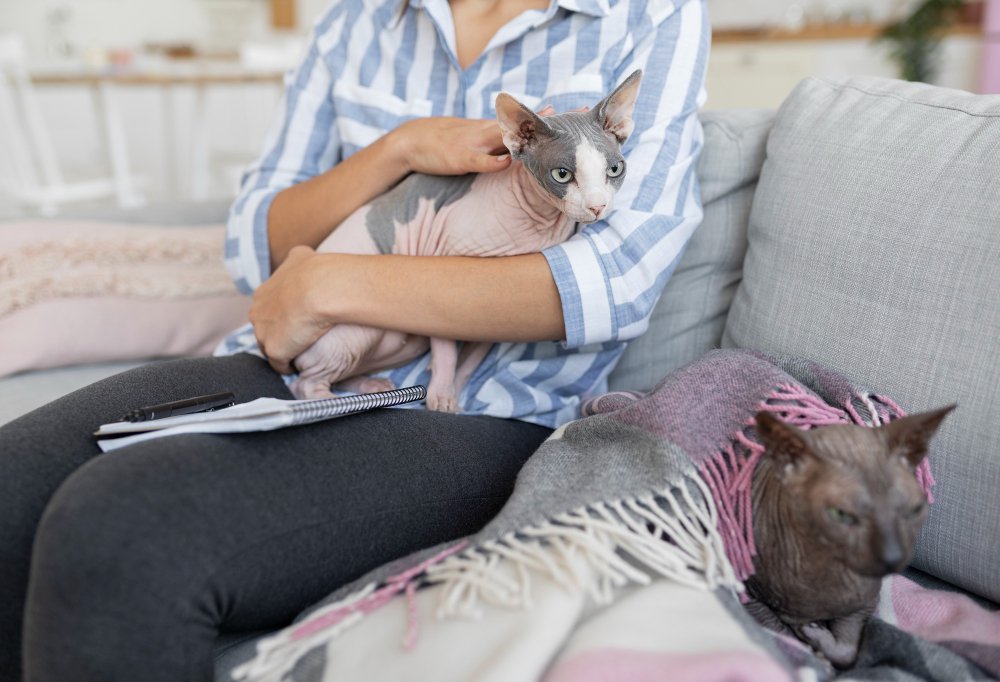
Relaxed body language
Indicators of a cat’s comfort and well-being can often be seen in their body language. A cat that is relaxed will typically have a loose posture, with their body lying comfortably on the surface they are on. Their tail may be gently swaying or tucked neatly beside them. Ears are usually upright or slightly forward, showing interest in their surroundings.
When a cat is feeling content and at ease, they may also exhibit behaviors like slow blinking, kneading with their paws, or even rolling over to expose their belly. These are all signs that your feline friend is feeling comfortable and safe in their environment.
No chronic hiding
Relaxed cats will often choose to lounge in places where they can observe the world around them, such as perched on a windowsill or on a favorite chair. If your cat is constantly hiding and only coming out for brief periods, it may be a sign that they are not feeling comfortable or safe in their environment. Chronic hiding can be a red flag for stress, anxiety, or even underlying health issues.
Any changes in your cat’s behavior, such as increased hiding or avoiding interaction, should be taken seriously. It’s crucial to create a safe and comfortable environment for your feline friend to thrive and feel at ease in their home.
Aging and Longevity Signs
Gradual behavioral changes
Signs of aging in your cat can manifest as gradual behavioral changes that may include increased sleep time, decreased interest in play, or changes in social interaction with family members.
Cats are known for their independent nature, but sudden shifts in behavior could be a sign of underlying health issues or discomfort.
Pay close attention to any changes in your cat’s routine or behavior as they age. Consulting with your veterinarian can help determine if these changes are simply a natural part of the aging process or if there are underlying medical concerns that need to be addressed.
Age-appropriate activity levels
Age-appropriate activity levels are necessary to your cat’s overall health and well-being as they age. While it’s normal for senior cats to have decreased energy levels compared to their younger counterparts, maintaining some level of activity is crucial to prevent obesity and promote physical and mental stimulation.
You have to adjust your cat’s exercise routines and playtime activities to match their age and physical capabilities. Engaging in interactive play sessions with appropriate toys or providing climbing structures can help keep your aging cat active and mentally sharp.
Sudden Behavior Changes
In order to better understand your cat, it is important to be aware of any abrupt changes in their behavior. Cats are unable to communicate when they are not feeling well, so it is our duty as responsible pet owners to remain observant. Familiarizing yourself with the key signs of sudden behavior changes is essential for all cat owners.
Immediate vet consultation
The moment you notice any abrupt changes in your cat’s behavior, it’s vital to seek immediate veterinary attention. Sudden aggression, excessive hiding, or drastic changes in appetite could indicate an underlying health issue that requires urgent care.
Don’t wait and monitor the situation – prompt veterinary consultation is key to addressing potential problems early and ensuring the well-being of your beloved feline friend.
Be observant of any unusual behaviors, such as lethargy, restlessness, or avoiding usual interactions. Cats are masters at hiding discomfort, so any deviation from their normal demeanor should be taken seriously.
Bear in mind, you know your cat best, and any behavior that seems out of character could be a red flag for an underlying medical condition.
Quick health assessment
Immediate action is crucial when conducting a quick health assessment on your cat. If you notice sudden changes in their behavior, start by checking for any visible signs of distress or discomfort. Look for symptoms like vomiting, diarrhea, abnormal breathing, or changes in litter box habits. These can all indicate potential health issues that require prompt attention.
This quick health assessment can help you provide vital information to your veterinarian, aiding in a faster and more accurate diagnosis.
Remember to stay calm and focused while assessing your cat’s condition, as your observations play a crucial role in determining the best course of action for their health and well-being.
Affection and Bonding
Many cat owners understand the importance of affection and bonding with their feline friends. Cats are known for their independent nature, but they also form strong attachments with their humans. Understanding the signs of affection that cats display can help strengthen the bond between you and your furry companion.
Purring and Kneading
Purring is a traditional indicator of a joyful and satisfied feline. Cats frequently purr when receiving affection, snuggles, or simply feeling at ease.
Another sign of contentment is kneading, where a cat gently presses their paws in and out against a soft surface. This behavior is commonly observed in kittens while nursing from their mothers and may continue into adulthood as a means for cats to express comfort and affection.
Close Physical Proximity
To form a strong bond with your cat, it’s essental to recognize the significance of close physical proximity. Cats that choose to sit close to you, sleep near you, or even follow you from room to room are showing their desire to be near you. This behavior demonstrates trust and affection, as cats will only seek close physical proximity with those they feel comfortable and safe around.
A cat’s desire for close physical proximity can vary based on their personality and past experiences. Some cats may be more independent and only seek out closeness on their terms, while others may be more clingy and constantly by your side.
It is essential to comprehend and honor your cat’s personal boundaries regarding physical closeness in order to establish a solid and trusting relationship.
Temperature Regulation
Many cat owners may not realize that their feline friends have a unique way of regulating their body temperature. Understanding how cats respond to temperature changes can help you ensure that your pet is comfortable and healthy in any environment.
Seeking cool or warmth
For cats, seeking cool or warmth is a vital part of their temperature regulation. When your cat is too hot, you may notice them seeking out cool surfaces to lie on, such as tiles or hardwood floors.
They may also exhibit behaviors like panting or seeking out shady spots to cool down. On the other hand, if your cat is cold, they may seek out warm spots like sunny windowsills or cozy blankets to snuggle up in.
It is crucial to observe these behaviors and offer your cat choices for cooling off and heating up, especially in very hot or cold weather. Providing your cat with access to water, shade, and comfortable bedding can help keep them comfortable throughout the year.
Appropriate seasonal responses
One key aspect of cat temperature regulation is their ability to adapt to seasonal changes. Cats have a thick coat that helps keep them warm in the winter and sheds to a lighter coat in the summer to help them stay cool. They may also seek out warmer or cooler areas in your home depending on the season.
Appropriate seasonal responses involve recognizing when your cat needs extra warmth or coolness and providing them with the necessary resources. For example, in the winter, you may want to provide your cat with a cozy bed or blanket to snuggle in, while in the summer, you can help keep them cool by providing access to cool rooms or a fan.
Stress and Anxiety Indicators
Unlike dogs, cats are masters at hiding their stress and anxiety. As a responsible cat owner, it’s necessary to be able to recognize the subtle signs that your feline friend may be experiencing heightened levels of stress. By being attuned to these indicators, you can provide the necessary support and comfort to help your cat feel safe and secure.
Increased grooming or hiding
If you observe your cat spending more time grooming or hiding than usual, it could be a sign that they are experiencing stress or anxiety. Excessive grooming that leads to bald patches or skin irritation may indicate underlying stress, while hiding in unusual places or being more reclusive than usual could suggest feelings of being overwhelmed.
Additionally, cats may groom excessively as a way to self-soothe when they are feeling anxious. Keep an eye on your cat’s grooming habits and behavior patterns to identify any changes that could signal heightened stress levels.
Avoidance or aggression
Aggression or avoidance behaviors can also be signs of stress or anxiety in cats. If your cat starts lashing out or displaying aggressive behaviors towards you, other pets, or objects in the home, it may be a manifestation of underlying stress. Likewise, if your cat begins avoiding interactions with you or seeks out isolation more frequently, it could indicate that they are feeling overwhelmed.
Moreover, if avoidance or aggression is excessive, it can adversely affect your cat’s overall health and potentially escalate behavioral problems if not dealt with promptly.
It is crucial to closely monitor your cat’s behavior and body language to identify the source of their stress, and take proactive measures to ensure they feel at ease and safe in their surroundings.
Signs of Feline Happiness
For cat owners, understanding the signs of feline happiness is crucial to ensuring the well-being and contentment of their beloved pets.
Cats communicate their emotions in subtle ways, and being able to recognize these signs can strengthen the bond between you and your feline companion. Here are some necessary signs that indicate your cat is happy and content.
Slow blinking eyes
An unmistakable sign of a content cat is when they give you slow, deliberate blinks. This behavior, known as “slow blinking,” is a sign of trust and affection in the feline world.
When your cat closes their eyes at you and opens them slowly, it signifies that they feel safe and comfortable in your presence.
By reciprocating with a slow blink of your own, you’re strengthening the bond and showing your cat that you trust them as well.
Tummy exposure
When your cat shows you their tummy, it’s a sign that they are feeling content and at ease. It’s a gesture of trust and vulnerability when they roll over to reveal their belly. While some cats may enjoy belly rubs, others may not want to be touched in that area. It’s important to respect your cat’s boundaries and preferences regarding tummy exposure, as forcing physical contact can cause stress or discomfort.
Feline contentment can be indicated by various body language cues, including relaxed body posture, purring, and playful behavior. Remember that every cat is unique, so it’s necessary to observe your feline companion’s individual cues and preferences to ensure their happiness and well-being.
Appetite Fluctuation Warnings
In order to keep your cat healthy, it is crucial to monitor their eating habits closely. Any sudden changes in appetite, such as a decrease or increase, could indicate potential health problems. This chapter will cover two common warning signs of appetite fluctuations that all cat owners should know about.
Refusing favorite foods
Any refusal of your cat to eat their favorite foods should raise a red flag. Cats are known for their finicky eating habits, so if your cat suddenly turns up their nose at a meal they used to love, it could indicate a potential health problem. It’s crucial to monitor this behavior closely and consult with your veterinarian if the refusal persists.
Sometimes cats may refuse certain foods due to stress or changes in their environment. However, if the refusal is accompanied by other symptoms such as weight loss, lethargy, or vomiting, it’s crucial to seek professional advice promptly to rule out any serious underlying conditions.
Sudden overeating
One common sign of potential health issues in cats is sudden overeating. While it may seem harmless for your cat to indulge in a bit more food than usual, excessive eating can lead to various health problems such as obesity, diabetes, or gastrointestinal issues. It’s crucial to monitor your cat’s eating habits and ensure they are maintaining a healthy weight.
With sudden overeating, it’s crucial to evaluate possible reasons behind this behavior. Stress, anxiety, or underlying medical conditions could trigger excessive eating in cats.
If you notice your cat constantly overeating and gaining weight rapidly, it’s best to consult with your veterinarian to determine the underlying cause and establish a suitable plan to manage their eating habits.
Sleeping Habit Shifts
Now, let’s explore some common sleeping habit shifts that you may observe in your feline friend!
Oversleeping or Insomnia
Shifts in your cat’s sleeping patterns can be an indicator of underlying health issues. If you notice your cat oversleeping or experiencing insomnia, it’s vital to monitor their behavior closely.
Cats are known for their love of napping, but sudden excessive sleeping or difficulty falling asleep could be a sign of stress, pain, or a medical condition.
Keep an eye out for any changes in your cat’s energy levels, appetite, or overall demeanor. If you’re concerned about your cat’s sleeping habits, it’s best to consult with your veterinarian for further evaluation and guidance.
Changes in Favorite Spots
The places where your cat chooses to nap can also provide valuable insights into their well-being. Cats are creatures of habit, and sudden changes in their favorite spots may indicate a shift in their comfort levels or preferences. Pay attention to whether your cat is seeking out new cozy corners or avoiding their usual sleeping areas.
The location of your cat’s favorite resting spots can also be influenced by environmental factors such as temperature, sunlight, or noise levels. Understanding your cat’s preferences can help you create a comfortable and stress-free space for them to relax and sleep peacefully.
For instance, if your cat used to love napping in a sunny spot by the window but now prefers a quiet corner in the bedroom, it could be a sign that they are seeking more privacy or tranquility. Making small adjustments to their sleeping environment based on these preferences can help support your cat’s overall well-being.
Heart Health Warning Signs
Once more, it is crucial for cat owners to stay alert to their cats’ heart health. Identifying the early signs of heart problems can enable you to give prompt attention and guarantee a higher quality of life for your cherished pet. Listed below are some key indicators to keep an eye out for:
Unusual Lethargy
For cat owners, lethargy in their pets can be a common concern. However, if you notice unusual lethargy in your cat, it could be a sign of heart problems. Cats with heart issues may become more tired and less active than usual. If your usually playful and energetic cat suddenly seems disinterested in activities or sleeping more than usual, it’s time to consult your veterinarian.
Additionally, keep an eye out for any reluctance to move or exercise, excessive fatigue after minimal activity, or a general lack of energy. These could all be indicators that your cat’s heart is not functioning as it should.
Fainting or Collapses
With regards to fainting or collapses, these are serious signs that should never be ignored. If your cat experiences sudden fainting spells or collapses, it could be a result of an underlying heart condition. Fainting in cats can be caused by poor blood circulation due to heart problems, leading to a temporary loss of consciousness.
Collapses can be alarming and may occur suddenly without warning. If your cat collapses, it’s crucial to seek immediate veterinary attention. Your vet can conduct necessary tests to determine the cause of the collapse and provide appropriate treatment to manage your cat’s heart health.
Neurological Alert Signals
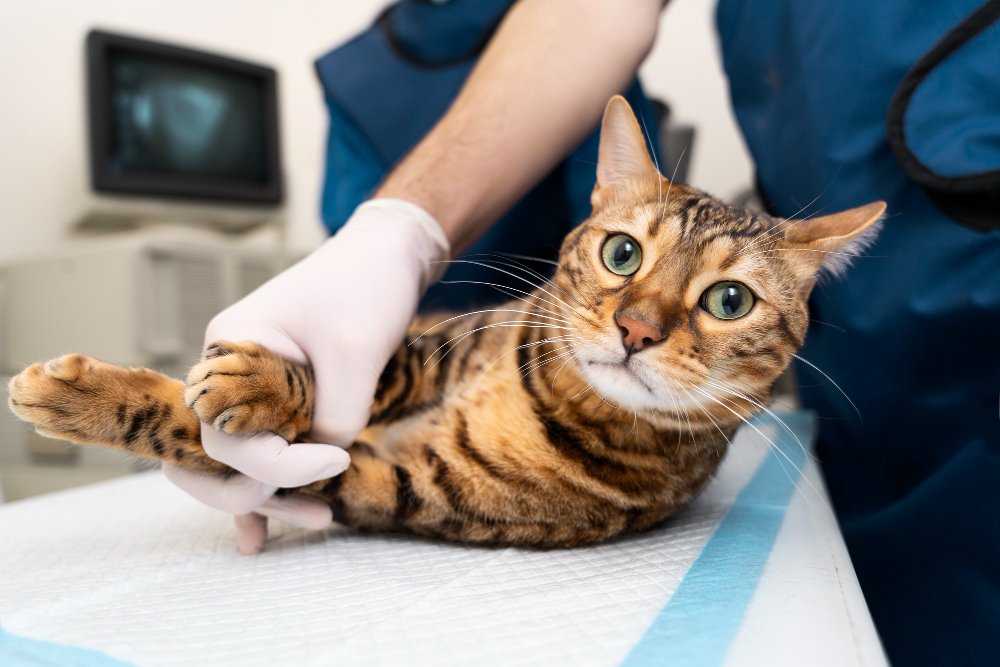
Despite cats being generally independent creatures, it is crucial for cat owners to be aware of certain neurological alert signals that could indicate a health issue. Recognizing these signs early can help in providing timely medical attention and ensuring the well-being of your feline friend.
Seizures or tremors
Seizures in cats can be a frightening experience for both the cat and the owner. If your cat experiences seizures or tremors where they exhibit uncontrolled shaking or convulsions, it is vital to seek immediate veterinary care. Seizures can be caused by various underlying health issues such as epilepsy, toxins, or neurological disorders.
Furthermore, disorientation or confusion in cats can be another indicator of a neurological problem. If you notice your cat appearing lost, unsure of their surroundings, or exhibiting unusual behavior such as walking into walls, it is imperative to consult with your veterinarian promptly.
Disorientation or confusion
Disorientation or confusion in cats can be a sign of a brain-related issue such as a tumor, infection, or cognitive dysfunction. Cats experiencing disorientation may seem lost or unable to navigate familiar spaces. If you observe such behavior in your cat, it is advisable to schedule a veterinary appointment for a thorough evaluation and appropriate treatment.
Neurological
Neurological alert signals in cats should never be ignored, as they can indicate serious health concerns that require immediate attention. Understanding these signs and being vigilant about any changes in your cat’s behavior can help in detecting potential health issues early on and ensuring prompt intervention to maintain your cat’s health and well-being.
Emergency Symptoms to Note
Once again, it’s crucial for cat owners to be vigilant and mindful of any emergency symptoms that may arise. Knowing how to identify and respond to these signs could potentially save your cat’s life. Here are some necessary emergency symptoms to watch out for:
Sudden paralysis
Symptoms of sudden paralysis in cats can include the inability to move certain body parts, dragging of limbs, and a lack of coordination. If you notice your cat experiencing sudden paralysis, it is important to seek immediate veterinary care. This could be a sign of a serious underlying issue such as a spinal injury, blood clot, or neurological disorder.
It’s necessary to keep your cat as calm and still as possible while transporting them to the vet. Avoid moving your cat excessively as this can worsen their condition. Be mindful of, prompt medical attention is crucial in cases of sudden paralysis to prevent further complications.
Uncontrollable bleeding
Uncontrollable bleeding in cats can be a life-threatening emergency that requires immediate attention. Signs of uncontrollable bleeding include blood gushing from a wound, bleeding that doesn’t stop with pressure, or bleeding from the nose, mouth, or other orifices. If you notice any of these symptoms, it’s vital to act quickly and get your cat to the vet as soon as possible.
With uncontrollable bleeding, it’s important to apply pressure to the wound using a clean cloth or gauze while transporting your cat to the vet. Do not attempt to remove any embedded objects causing the bleeding, as this could further exacerbate the situation. Quick action is key in cases of uncontrollable bleeding to help prevent shock and ensure the best possible outcome for your cat.
Parasite Infestation Evidence
Fleas or ticks spotted
Fleas or ticks spotted on your cat’s fur is a clear indication of a potential parasite infestation. These tiny pests can often be seen crawling around your cat’s body, especially in areas with less fur such as the neck, ears, and belly. If you notice any fleas or ticks on your cat, it is crucial to take immediate action to prevent the infestation from spreading.
Ticks can be particularly dangerous as they can transmit diseases such as Lyme disease to both cats and humans. Make sure to carefully remove any ticks using tweezers and consult your veterinarian for further guidance on treatment and prevention.
Excessive scratching
An increase in your cat’s scratching behavior can be a sign of fleas or other parasites. Cats may scratch excessively to relieve the itching caused by flea bites or other skin irritations. If you notice your cat scratching more than usual, it is important to inspect their fur for any signs of fleas or ticks.
The presence of flea dirt, which looks like small black specks on your cat’s fur, is another common indicator of a flea infestation. Flea dirt is actually flea feces and is a sure sign that your cat has fleas and needs treatment.
Allergic Reaction Signs
Despite our best efforts to provide the best care for our feline friends, cats can still experience allergic reactions. It’s crucial for cat owners to be able to recognize the signs of an allergic reaction in their pets in order to provide timely medical attention and relief. Here are some crucial signs to watch out for:
Swelling or hives
The first sign of an allergic reaction in cats may present as swelling or hives on their skin. This can often be accompanied by redness and itchiness in the affected areas. Swelling or hives can occur due to various allergens such as certain foods, insect bites, or environmental factors. It’s important to monitor your cat closely for any unusual changes in their skin condition.
The presence of swelling or hives should not be ignored, as it can lead to discomfort and potentially escalate into a more severe allergic reaction. If you notice any signs of swelling or hives on your cat, consult your veterinarian immediately for proper diagnosis and treatment.
Excessive sneezing
Excessive sneezing in cats can be a sign of an allergic reaction to irritants such as dust, pollen, or mold. If your cat starts sneezing frequently and displays other signs of respiratory distress like watery eyes or nasal discharge, it’s crucial to address the situation promptly. Allergic reactions that affect the respiratory system can worsen and lead to more severe complications if left untreated.
Recognizing the signs of excessive sneezing in your cat can help you identify potential allergies and take the necessary steps to manage their symptoms. Consult your veterinarian for proper diagnosis and treatment options to ensure your cat’s well-being.
Joint and Mobility Issues
Noticing changes in your cat’s mobility can be concerning for any cat owner. Joint and mobility issues can affect cats of all ages, causing discomfort and impacting their quality of life. It is important to be aware of the signs that indicate your cat may be experiencing joint problems so that you can seek appropriate treatment and support.
Limping or stiffness
With joint and mobility issues, you may observe your cat limping or showing signs of stiffness, especially after resting or engaging in physical activity. If your cat is favoring one leg or showing reluctance to put weight on a certain limb, it could be a sign of joint pain or arthritis. Monitor your cat’s activities and behavior closely, and seek advice from your veterinarian if you observe sustained limping or stiffness.
Cats are masters at hiding discomfort, so subtle changes in their gait or mobility should not be ignored. Early detection and intervention can help manage joint issues effectively and improve your cat’s quality of life. Your veterinarian may recommend treatments such as joint supplements, pain medication, or physical therapy to help your cat move more comfortably.
Avoidance of jumping
Jumping is a common activity for many cats, whether they are leaping onto high surfaces or chasing after toys. If you notice your cat avoiding jumping or having difficulty with vertical movements, it could be a sign of joint and mobility issues.
Cats with arthritis or joint pain may find it challenging to engage in activities that require jumping, leading to a decrease in their overall mobility and agility.
Joint issues can make it painful for cats to exert the physical effort needed for jumping. Providing alternative strategies for your cat to access elevated surfaces, such as ramps or steps, can help alleviate stress on their joints and make it easier for them to navigate their environment.
By recognizing and addressing your cat’s avoidance of jumping, you can make necessary adaptations to promote their comfort and well-being.
Owner Observation Necessity
Unlike dogs, cats are masters at hiding their discomfort or illness. As a responsible cat owner, it is crucial to be vigilant and observant of your feline friend’s behavior and health.
By closely observing your cat’s daily habits and regular routine, you can promptly notice any potential issues and promptly seek veterinary care.
Regular Health Checks
Any cat owner should make regular health checks a priority. This includes monitoring your cat’s weight, eating habits, and litter box usage. Sudden changes in weight, appetite, or litter box behavior can be early signs of underlying health issues such as diabetes, kidney disease, or gastrointestinal problems. By keeping track of these basic indicators, you can catch any problems before they escalate.
It is also important to schedule regular veterinary visits for thorough check-ups. Your vet can conduct comprehensive physical exams, administer necessary vaccinations, and provide preventive care to keep your cat healthy and happy. Be mindful of, preventive care is often more effective and less costly than treating advanced illnesses.
Observation of subtle changes
One key aspect of being a vigilant cat owner is observing subtle changes in your cat’s behavior or appearance. Cats are known for their stoic nature, making it challenging to detect signs of pain or discomfort.
Look out for subtle changes such as decreased grooming, hiding more than usual, changes in vocalization, or unusual aggression. These could be indicators of underlying health issues or stress that require prompt attention.
With their mysterious and independent nature, cats rely on their owners to be their advocates and caretakers. By staying observant and proactive in monitoring your cat’s health and behavior, you can ensure a long and healthy life for your beloved feline companion.
To wrap up
The 35 vital signs that every cat owner needs to know are indispensable for ensuring the health and well-being of our feline companions.
Recognizing these signs enables us to detect potential health issues early and provide appropriate care, ultimately enhancing the quality of life for our beloved cats.
By staying alert and informed, we empower ourselves to be proactive in addressing any concerns that may arise, ensuring that our cats receive the best possible care.
Do not forget, being attuned to your cat’s behavior, body language, and overall well-being is key in maintaining a strong bond with them and addressing any health issues promptly.
By familiarizing yourself with these vital signs, you are better equipped to provide the love, support, and care that your feline friend deserves.
Stay vigilant, observant, and proactive in monitoring your cat’s health, and you will be able to ensure a happy and healthy life for your precious pet.






